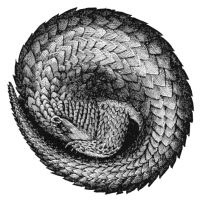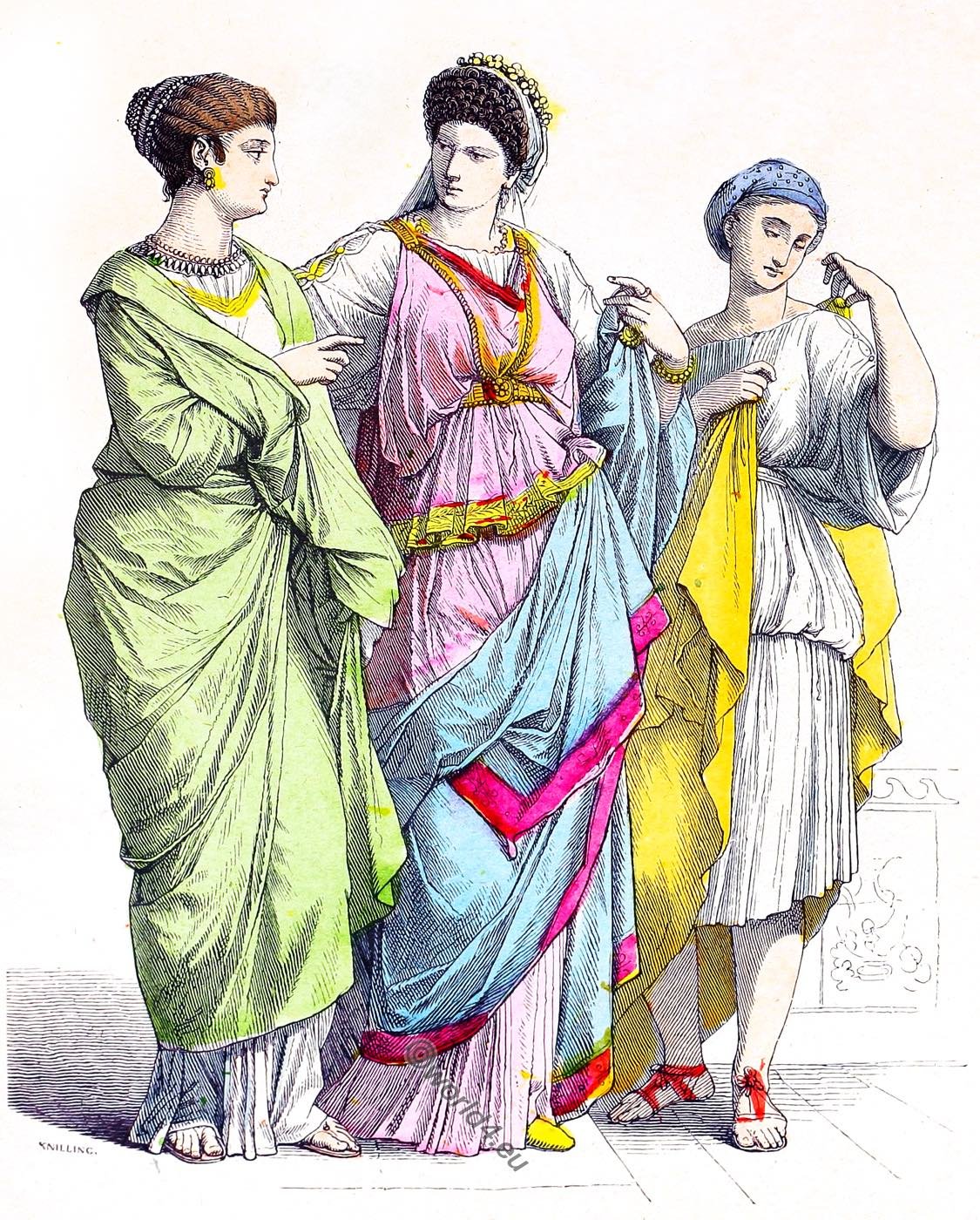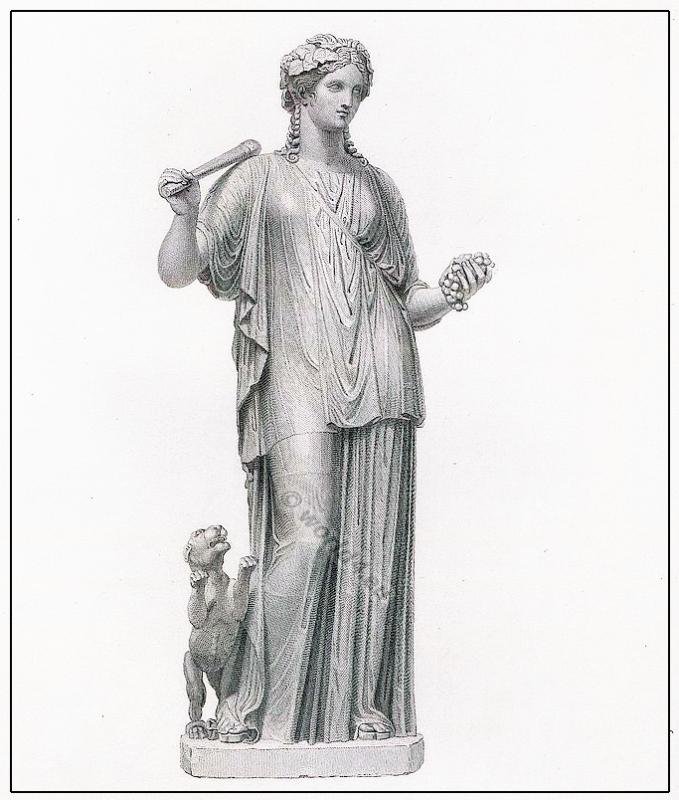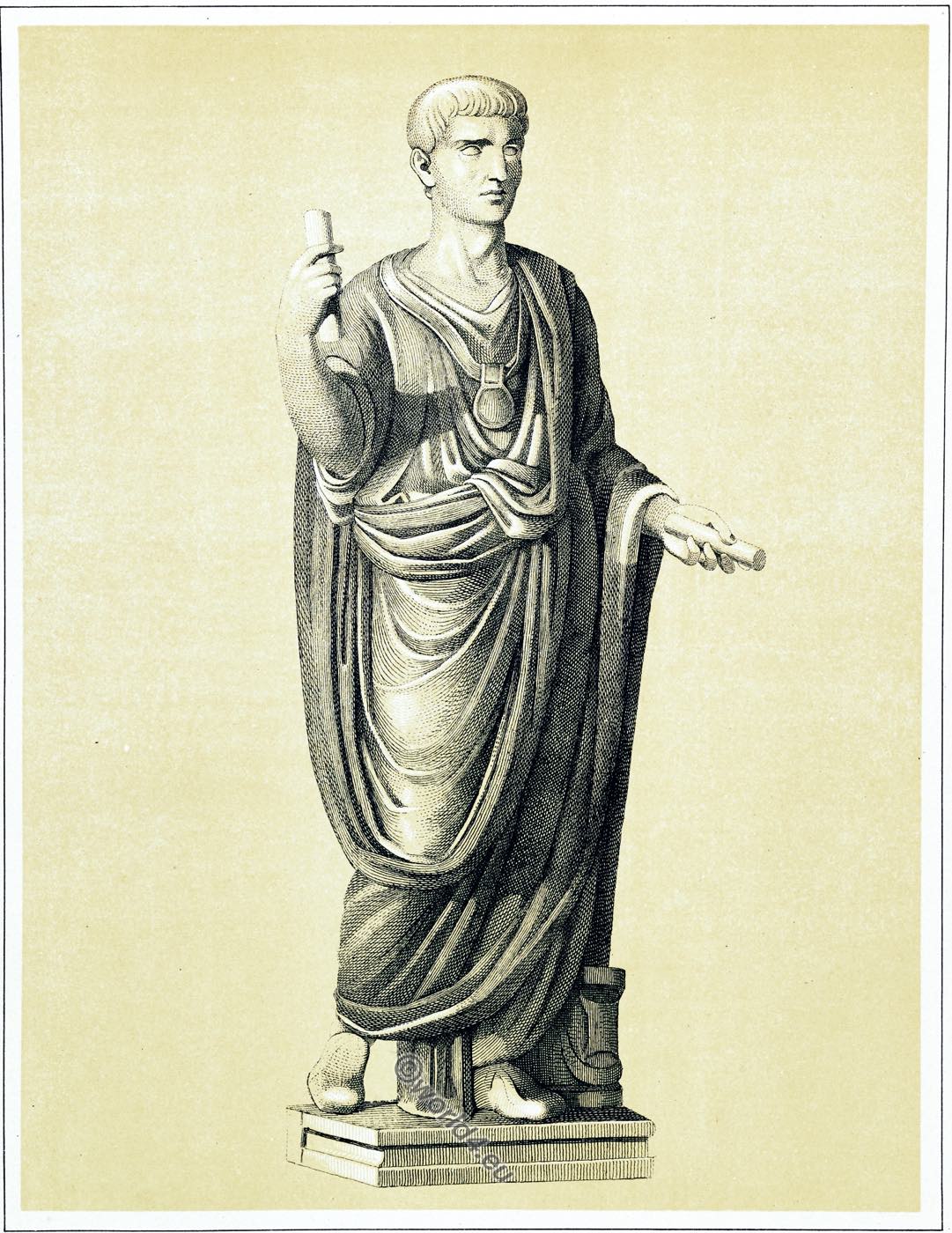ROME.
Chapter:
Monarchic and Republican Rome (753-29 BC).
Roman Britain (AD 78-438).
Imperial Rome (29 BC.- AD 400); The Goths.
THE ROMAN COSTUME IN ANTIQUITY.
Roman clothing in its diversity and development.
The Toga was the national costume of the Romans who preferred sumptuousness to the real beauty of line and grace. It was made mostly of wool which was dyed many beautiful shades of blue, green, yellow, and red, but the Toga was also often worn in its natural yellowish color or sometimes bleached.
Their jewels consisted of necklaces, bracelets, and rings which were made of gold and silver, and even of the base metals; semi-precious stones were sometimes used. However, their jewels emphasized the rank of the women who wore them. A difference in the hair-do was also noticed between the classes, as the slave wore their hair short while the high class ladies kept their hair very long.
The type of decoration used by the Romans, in the various parts of their edifices and decorations varied considerably from that of the Greeks, their art appeared as if it were entirely for self-glory.
We derive the major part of our information about Roman forms from the excavated city of Pompeii, hence the reason this style is often called Pompeian. Their whole system of decoration seems to have been based from very few motifs and figures. It may be said also that many of these compositions now are considered rather vulgar.
However, the execution of these designs was so exquisite and so perfectly rendered that they are extremely pleasing to the eye. Very few printed ornaments are to be seen, and these are really the same as those in Pompeii. There is no originality in the coloring and most forms are copies of Greek Art.
The most used motif in the Roman composition is the scroll, grouping together leaf after leaf of the Acanthus plant which the Greek had used with more artistic skill. In their arrangement of this particular design, the Roman exaggerated a great deal from their desire to create a feeling of admiration.
This pattern of the Acanthus leaf is so easily reproduced that modern designers have used it profusely.
HISTORICAL DATA
B.C.
- Many legends concerning the foundation of Rome have been preserved, but April 21st, 753 B.C., is officially accepted as the date. “Rome was not built in a day.” Its first walls were not erected until nearly two hundred years after its foundation. Its government was monarchic until the ejection of the Tarquins in 510 B.C. The appointment of the first consul occurred in the following year, and this (509) marks
THE BEGINNING OF THE REPUBLIC.
- 396. The first war of importance was waged against the Veii, and the fall of the Etruscan city took place in 396. During this campaign the Roman soldiers received pay for the first time, and a standing army was formed on this basis.
- 390. The Gauls under Brennus defeated the Romans at the River Allia, but were afterwards routed by Camillus (389).
- 387. The Gauls took Rome and besieged the Capitol, but it was saved by the cackling of Juno’s geese. The Gauls retired in 361 and were defeated in 358.
- 340. War with the Latins and Samites.
- 311. War with the Etruscans.
- 266. Rome supreme in Italy.
- 264. The First Punic War. Gladiators were introduced from Etruria and gave their first performance in Rome.
- 238. War with the Gauls.
- 235. Naevius (d. 204) produced his first comedy.
- 218. The Second Punic War. Hannibal (247-184).
- 215. The First Macedonian War.
- 200. The Second Macedonian War.
- 174. The expense of stage plays taken over by the State.
- 171. The Third Macedonian War.
- 167. Polybius, the Greek statesman and historian (204-122), brought a prisoner to Rome.
- 156. The Third Punic War.
- 146. Destruction of Corinth by Lucius Mummius. End of Greek independence.
- 133. The Age of Gracchi.
- 104. General Caius Marius (157-87) became a ruler of Rome; a great reformer and organiser of the army.
- 88. War against Mithridates, King of Macedon.
- 66. He is defeated and becomes a fugitive.
- 62. Praetorship of Caius Julius Caesar. First expedition (55) into Britain.
- 54. Second expedition into Britain.
- 51. The conquest of Gaul complete; it becomes a province of Rome.
- 48. Caius Julius Caesar (100-44) the first to become sole and perpetual dictator. Assassinated in 44.
- 37. Jerusalem captured, and Herod nominated king.
- 31. Octavius succeeds to the dictatorship. Battle of Actium.
- 30. End of Antony and Cleopatra’s rule, and of Egyptian independence.
- 29. The title of “Augustus” (Honourable) given to Octavius Imperator.
END OF THE ROMAN REPUBLIC.
INTRODUCTION
DURING the course of centuries the flame of Roman civilization, fanned by increasing prosperity, a growing commerce, and an efficient and victorious military organization, grew to a great blazing light that eclipsed the civilizations that had gone before.
Greek civilization waned politically, although the intellectual domination of Grecian culture remained intact and swayed the thought of the world and moulded its culture. But Rome grew in power and enterprise, and the early days of its power as a State were its true days of greatness, for later it became vulgarized, commercial and debased.
The Romans were essentially men of action, and they did not develop an individual art; their art was based on Greek models, which they copied without much discernment, bringing to the purity of Greek design a harsh, mathematical touch; the artistic ineptitude of sternly practical and essentially unappreciative men. Laws, customs, art and literature all had something of Grecian influence in their fabric, so it is not surprising to find a marked similarity between Greek and Roman costume.
PLAUTUS, d. 184 B.C.; CATO THE ELDER, d. 149 B.C.; CICERO, d. 43 B.C.; VIRGIL,
19 B.C.; HORACE, d. 8 B.C., are a few of the literary men of the Republican Age.
Continuing






